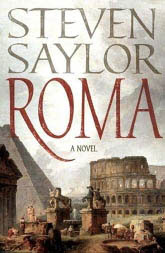Thus the story begins much earlier than the birth of the mythological twins, in the VIIIth century. Saylor's narrative begins about 1000 b.C., in the banks of the Tiber, where Lars and her daughter Lara initiate the cult of Fascinus, the flying phallus. Of course, it may not be a coincidence that Lara is the name of a Tiber nymph and mother of the Lares. Here begins Saylor's ingenious mixing of myth, legend and history, best seen in Chapter II, presenting as the legend of Cacus and Hercules, and that's also when we see for the first time the Potitii, descendents from Lara and the Fascinus wearers, and the Pinarii - and the legendary origin of the herculean cult in Rome, as told by Vergil in Aen. VIII, 262-279. Always skillfully, through the rest of the book we witness the legendary birth of the Roman Republic, in 753 b.C. (chapter III), the Republic, Coriolanus's sedition and Lucretia suicide (chapter IV), Verginia's rape and the XII tables (chapter V), the capitoline geese and the Gauls (chapter VI), Appius Claudius Caecus and the building of the Appian Way (chapter VII), Scipio Africanus and Plautus (chapter VIII), the Gracchi (chapter IX), Sulla's horror and young Caesar (chapter X), and finally the rise of Octavianus (chapter XI).
We could be lead to think such a large chronological span would become a fragmentary narrative. It is not. Roma is rather a coherent and fascinating narrative fabric. And, as usual, Saylor's erudition is irreprochable - but, what's most, it nevers get boring, it never sounds as a History lecture, as it happens with so many historical fiction writers. Saylor's narrative is vivide and dynamical, we often think he actually was there, witnissing all and telling us what he really saw (please Steven, take me with you next time you travell to ancient Rome). And that's not something easy to do: the trick in historical fiction is to make us believe the author was there, and make us think "I know this is not real, I know I'm being dupped, but I like it and I don't care, as this could and may have happened just like he says".
But to forget willfully this was writen not by a roman but by a XXIst century man, that's only one of Roma's many qualities. Roma is an excellent novel, skillfully writen, a finest historical fiction, proving once again (if necessary) Steven Saylor is one of the best storytellers in modern fiction.
About the didactical qualities of this novel, that's something to talk about in another post. Coming soon.




Sem comentários:
Enviar um comentário